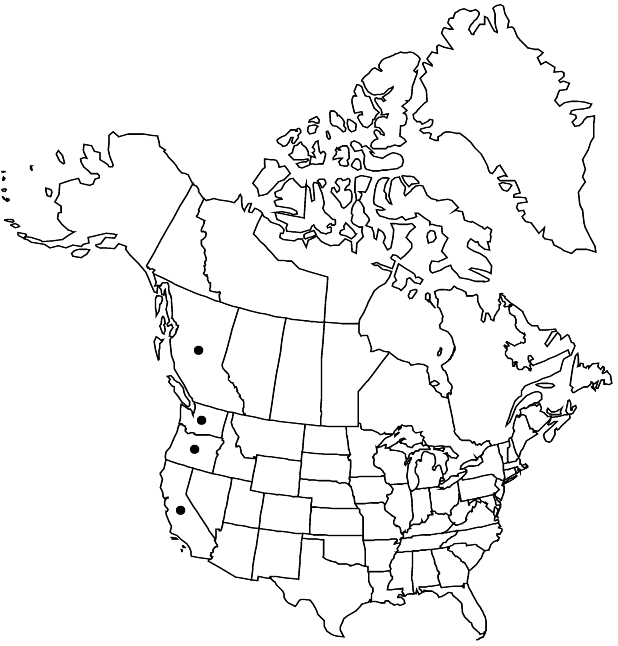Dodecatheon hendersonii
Bot. Gaz. 11: 233. 1886 (as hendersoni) ,.
Plants (7–) 10–50 (–55) cm; scape glandular (at least distally) or glabrous. Caudices not obvious at anthesis; roots usually whitish; bulblets present or absent. Leaves 0.5–14 (–16) × (1–) 1.5–6 (–7) cm; petiole slightly, if at all, winged; blade usually oblanceolate to elliptic or spatulate, sometimes ovate to nearly rounded, base somewhat decurrent into stem, abruptly tapering to petiole, margins entire, surfaces glabrous. Inflorescences 2–17-flowered; bracts narrowly to broadly lanceolate, 3–10 (–15) mm, usually glabrous, sometimes glandular. Pedicels 2–7 cm, glandular or glabrous. Flowers: calyx green or greenish with reddish or purple speckles, 5–10 mm, glandular-puberulent or glabrous, tube 1.5–3 mm, lobes 4–5, 3–8 mm; corolla-tube yellow or whitish with reddish to reddish purple, thick, wavy ring, lobes 4–5 (often on same plant), usually magenta to lavender, sometimes white, 6–25 (–28) mm; filaments connate, tube dark maroon, 1–3.5 × 1–4 mm; anthers 2.5–6 mm; pollen-sacs usually deep red to purple or maroon, sometimes yellow and often speckled with red or maroon, connective dark maroon to black, transversely rugose (infrequently seemingly longitudinally wrinkled); stigma not enlarged compared to style. Capsules green or greenish, sometimes speckled purple or reddish, operculate or valvate, cylindric-ovoid, 7–17 (–19) × 4–7 (–9) mm, glabrous or glandular-puberulent; walls thin, pliable. Seeds without membrane along edges. 2n = 44, 66, 88, 132.
Phenology: Flowering winter–early summer.
Habitat: Grasslands or meadow communities, or oak and conifer woodlands, often in shady places
Elevation: 0-1900(-2100) m
Distribution

B.C., Calif., Oreg., Wash.
Discussion
Dodecatheon hendersonii occurs from southern Vancouver Island in the coastal ranges to west-central California (as far as San Benito County) and is disjunct into the San Bernardino Mountains in southern California. To the east, the species is found on the Siskiyou Mountains and in the Sierra Nevada of California to Tulare County. A Macoun (s.n., DAO) specimen supposedly gathered at Yale, British Columbia, may be misattributed (K. I. Beamish 1955); all other known localities are from Vancouver Island.
Inasmuch as bulblets and mature capsules are rarely collected, it is difficult to clearly distinguish between var. hendersonii and var. hansenii. The former may be broadly characterized as plants bearing bulblets at anthesis with sparsely glandular scapes, pedicels, and, sometimes, calyces. The calyx of var. hendersonii is usually greenish with purple or reddish speckles. The most distinctive characteristics of this phase are a filament tube that is 1–2.5 mm wide and acute anther apices. It is found mainly along the coast from British Columbia to southern Oregon and in scattered locations in coastal California, with disjunct populations in the foothills of the central Sierra Nevada, and in the mountains of southern California. Variety hansenii is glabrous, lacks bulblets, and the calyx typically is green; it usually is found inland in the Siskiyou Mountains and the Sierra Nevada and scattered populations occur in the coastal ranges of northern California. The filaments in var. hansenii are broader, being tubes 1.5–4 mm wide, and anther apices are obtuse. Capsules of var. hendersonii are usually operculate; those of var. hansenii appear to be consistently valvate. The 2n = 66 plants appear to be primarily individuals that produce little or no pollen.
Adding to the complexity is the close association of var. hansenii with Dodecatheon clevelandii var. patulum. The latter, like var. hendersonii, is basically a diploid or a tetraploid (2n = 44, 88), rather than a hexaploid, and one would expect no crossing between the two. Nonetheless, H. J. Thompson (1953) reported finding sterile individuals where D. hendersonii var. hansenii and D. clevelandii var. patulum were in close association. These sterile individuals were morphologically similar to var. hansenii (and not intermediate between the two), and sterile individuals were fairly common in populations of var. hansenii where no other Dodecatheon were present. Although the three entities may be characterized (see table 5 in Thompson), Thompson concluded that assigning names to some populations was difficult and could be established “only by a detailed consideration and summation of all the characters.”
H. J. Thompson (1953) recognized Dodecatheon hansenii; A. F. Cholewa and D. M. Henderson (1993) accepted only D. hendersonii. In their molecular study, A. R. Mast et al. (2004) considered the two entities distinct, albeit closely related, species. It is possible that var. hansenii had a hybrid origin involving var. hendersonii and D. clevelandii var. patulum, and backcrossing with var. hendersonii resulting in a series of morphological features that allies the hansenii phase more to D. hendersonii than to D. clevelandii. More study is needed, especially in areas where the two appear to have overlapping ranges in the Bay Area and Sierra Nevada foothills of California.
Selected References
None.
Lower Taxa
"reddish" is not a number. "maroon" is not a number. "purple" is not a number.